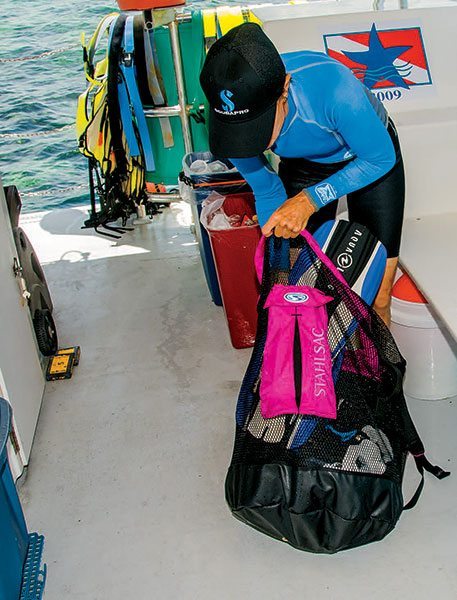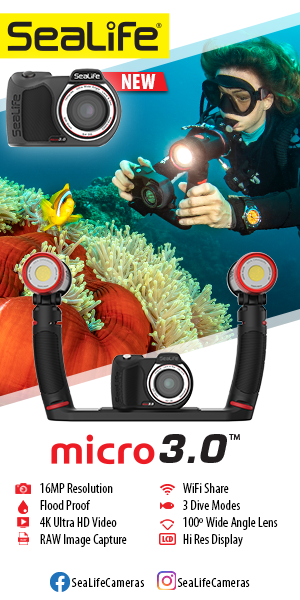Last month’s Scuba Skills column addressed the sequence used when preparing to dive from a charter boat. It began with boarding the vessel and ended with a giant stride into the water. This month’s column addresses the opposite end of the diving adventure: the sequence used to reboard the boat at the end of the dive.
Exiting onto a dive charter boat begins at the safety stop. Before final ascent, listen intently for noise from approaching boats and with your hand stretched overhead, rotate and scan the surface for danger above.
Immediately upon surfacing, do another “all clear” check of the area and establish positive buoyancy by using the power inflator to add air to the buoyancy compensator (BC). While at the surface, keep the regulator or snorkel in your mouth to avoid accidentally choking on water. Once floating comfortably, scan the horizon for your dive boat. Popular destinations often have more than one boatload of divers on the same site, so read the name on the hull before concluding that the boat you’ve sighted is the one you are supposed to board.
Reboarding an anchored vessel requires procedures different from those used when drift or live-boat diving. Either way, however, the crew on your boat is just as eager to see you as you are to see them, so when you make eye contact be sure to display a big “OK” signal. Use the onehanded finger tips of one hand touching the top of your head signal or the two-handed finger tips together forming an arm circle above your head. Either signal is easily understood, but avoid using a waving motion. This can be interpreted as a signal that you are in distress and need immediate assistance. Waving is likely to result in a crewmember hitting the water and swimming rapidly in your direction, or a chase boat springing into action. Waving should be avoided unless you actually do need assistance.
When diving from an anchored or moored boat try to return to the area beneath the vessel and then ascend using the anchor/mooring or descent line as a reference, or by making a free ascent next to the boat.
When diving in current, ascend near the bow and float back to the exit area on the surface. Anytime there is current present, avoid surfacing aft of the boat. If there is a tagline deployed, and there should be if current is present, grab it to avoid being swept away.
Once ahold of the line, look to the crew for instruction. During the boat briefing the divemaster probably explained how to exit the water, but wait for instruction in case conditions have changed and require a different technique. While holding onto the tag line, work your way toward the boat hand over hand, but do not exit until instructed to do so.
Exiting onto the boat when drift diving generally requires less swimming and navigation, as the boat typically follows, or at least comes to you, when you surface. At the predetermined time or remaining air supply, use the same caution as when surfacing onto a stationary vessel — look and listen for nearby or approaching boats or other dangers.
On the surface, establish positive buoyancy and visually locate your boat. Upon making eye contact with the crew, provide a big OK signal to let them know that you do not need assistance. When drift diving it isn’t that farfetched to surface and find no boat in sight. In this case deploy your inflatable and audible surface signaling devices, then wait. Once you sight a boat, give an OK signal even if you haven’t yet made eye contact with a crewmember. When the crew sees your signal they will return an OK to acknowledge your position. However, don’t panic if the boat heads off in another direction. Oftentimes groups of divers from the same boat surface significant distances apart and must be picked up one at a time. Unless there is a serious problem, the boat will soon be back for you.
Float comfortably until the boat approaches. Do not swim toward the vessel until instructed to do so. Typically the boat will circle and cautiously approach divers. Sometimes the boat will deploy a trail line (tagline) as it circles. The boat then is maneuvered so the line comes to within easy reach of the floating divers. Here again, avoid swimming to the rope; it will come to you.
Once you have a hold of the line, the boat will stop and you can pull yourself to the stern. However, do not attempt to climb aboard until the crew instructs you to do so. In most cases the captain will turn off the engine before issuing the signal to approach and climb aboard. Never swim to a boat whose propellers are turning (other than a very slow revolution caused by current) and don’t attempt to exit when the engine is running unless the crew says it is safe.
So, now you are floating near the exit ladder. The same basic exit technique is used whether exiting onto a stationary or drifting boat. However, some additional caution should be used to avoid being swept over by a live boat that is drifting your way as you prepare to exit.
A variety of exit techniques are used depending on the type of boat and the design of the exit apparatus. When the boat is not equipped with an exit ladder, most often the case with smaller boats, especially rigid hull inflatables, a deep-water exit is required. When staged at the side of the boat, switch to your snorkel and hand your weighting system to the crew, followed by your scuba rig. With mask and fins in place, firmly grasp the side of the boat as high on the gunwale as possible, sink down into the water and with a powerful kick and pull, propel yourself up and over the gunwale. The crew will assist as needed to haul you safely back into the boat.
Climbing a boat ladder is a bit easier. Rule No. 1 is, “don’t tailgate.” When staging near the ladder stay far enough away that the diver climbing the ladder will not hit you if he or she were to slip and fall back into the water.
Once it is your turn to exit, approach the ladder and follow the crew’s instructions. Most of the time you are asked to remove your fins and hand them up (or loop the straps around your wrists) before climbing the ladder. Or you may be instructed to climb the ladder without removing your fins, but always keep mask and snorkel or regulator in place. The technique used on a particular boat will be addressed in the dive briefing prior to the start of the dive.
Once on board, avoid blocking the exit area; as efficiently as possible return to your seat on the dive deck and remove your scuba unit. Watch your step and use caution to avoid setting your tank on someone else’s gear. And be sure to secure your tank before returning to the exit area to gather your fins, if applicable.
If it is the final dive of the boat trip, before disassembling your scuba unit inventory your gear and place it in your gear bag or adjacent to or beneath your seat. Then remove your regulator and BC and stow appropriately.
If the boat is equipped with a rinse container, it is a good idea to give your dive computer and possibly your regulator a quick dip before packing them away. The crew can tell you if the rinse container is reserved for camera gear or may be used for other items.
For me, exiting onto a boat is just as easy, if not easier, than walking out onto shore. Exercising a few basic cautions and following this simple step-by- step procedure will make it easy for you as well.
Story by Lynn Laymon | Photos by Barry and Ruth Guimbellot
See this skill in photos
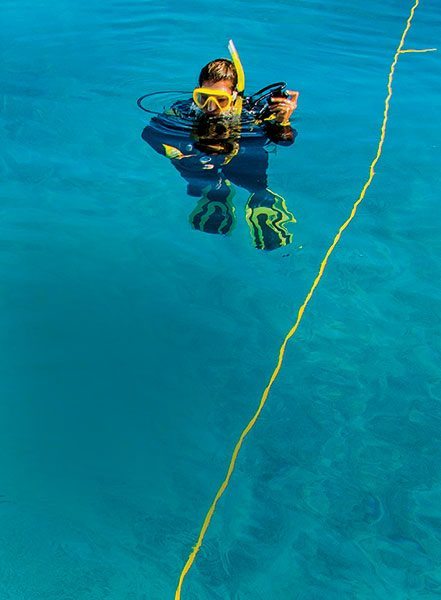
[ONE] When at the surface, keep your mask on your face and a regulator or snorkel in your mouth. Adjust your buoyancy so you can rest comfortably at the surface until it is your turn to board the boat.
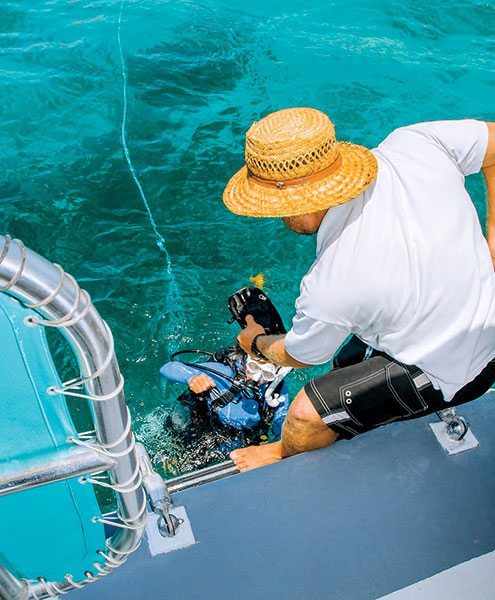
[TWO ] Passing up the weight system is mandatory when performing a deepwater exit, but some divers also prefer to lighten the load when climbing an exit ladder.
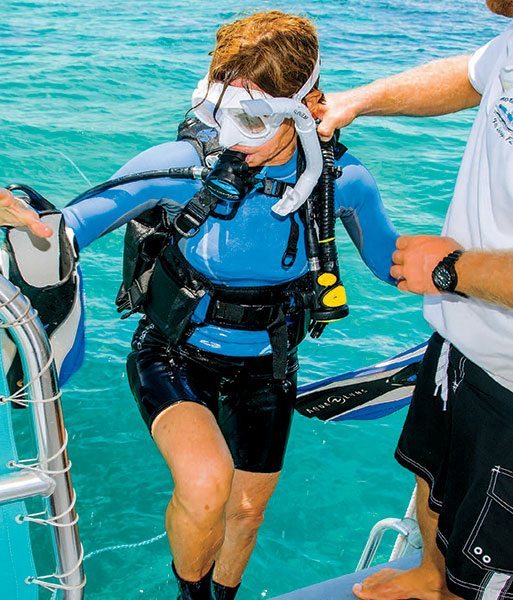
[THREE] When climbing an exit ladder always keep the regulator or snorkel in your mouth and don’t release your grip on the ladder until the other hand is firmly planted on the railing.

[FOUR] After exiting, avoid blocking the exit area; immediately proceed to your seat and remove the scuba unit.



